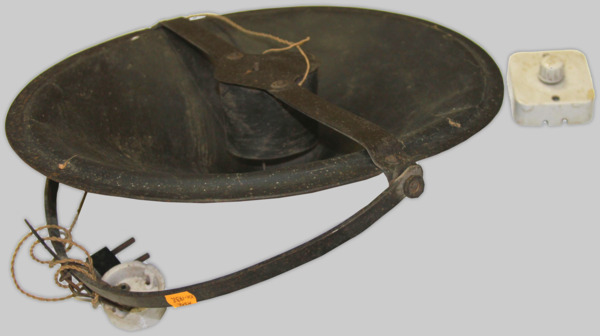The loudspeaker ‘Record’ from the collection of the Museum of the History of Tatar Statehood and the Republic of Tatarstan was manufactured in 1940s at Radio manufacturing plant No. 18 in Moscow.
The project of the electromagnetic reproducer was developed at Kalinin Leningrad plant in 1924. It was a household electronic device which was designed to receive and play programs transmitted through a wire broadcasting network. Dozens of different plants in the USSR produced it from 1925 to 1952.
A diffuser made of pressed paper, which was impregnated with a synthetic solution, was inside the loudspeaker. The radio converted an electric current into sound vibrations through this element. The device was connected to a radio current using a socket. Its power did not exceed 0.25 watts.
The loudspeaker ‘Record’ became a symbol of Soviet radio broadcasting in pre-war and war times. The writer Maxim Gorky said: ‘Radio, one of the greatest discoveries of science, one of the secrets which was snatched by science from feigned voiceless nature’.
In the 1920s, the loudspeaker became the most popular medium and the main channel of communication between the state and its citizens. The famous ‘black plate’ hung in almost every home and was of great cultural importance. It was not only the one source of information, but also an instrument of agitation and propaganda. With the help of such loudspeakers, labour reports, broadcasts of football matches and all-union news were transmitted.
Many names for the loudspeaker appeared in the 1930s: ‘reproducer’, ‘radio’, ‘liar’, but more often it was called — ‘plate’.
In 1941, the ‘black plates’ announced the beginning of the Great Patriotic War with the voice of the announcer Yury Levitan. Over the next four years, the radio broadcast information about the course of the battles, the losses and victories of the Red Army. Also, during these years, the loudspeaker performed a defensive function — it was used to inform the population about shelling and air raids. On May 9, 1945, Levitan announced the victory and the end of the war via the loudspeaker.
The project of the electromagnetic reproducer was developed at Kalinin Leningrad plant in 1924. It was a household electronic device which was designed to receive and play programs transmitted through a wire broadcasting network. Dozens of different plants in the USSR produced it from 1925 to 1952.
A diffuser made of pressed paper, which was impregnated with a synthetic solution, was inside the loudspeaker. The radio converted an electric current into sound vibrations through this element. The device was connected to a radio current using a socket. Its power did not exceed 0.25 watts.
The loudspeaker ‘Record’ became a symbol of Soviet radio broadcasting in pre-war and war times. The writer Maxim Gorky said: ‘Radio, one of the greatest discoveries of science, one of the secrets which was snatched by science from feigned voiceless nature’.
In the 1920s, the loudspeaker became the most popular medium and the main channel of communication between the state and its citizens. The famous ‘black plate’ hung in almost every home and was of great cultural importance. It was not only the one source of information, but also an instrument of agitation and propaganda. With the help of such loudspeakers, labour reports, broadcasts of football matches and all-union news were transmitted.
Many names for the loudspeaker appeared in the 1930s: ‘reproducer’, ‘radio’, ‘liar’, but more often it was called — ‘plate’.
In 1941, the ‘black plates’ announced the beginning of the Great Patriotic War with the voice of the announcer Yury Levitan. Over the next four years, the radio broadcast information about the course of the battles, the losses and victories of the Red Army. Also, during these years, the loudspeaker performed a defensive function — it was used to inform the population about shelling and air raids. On May 9, 1945, Levitan announced the victory and the end of the war via the loudspeaker.



